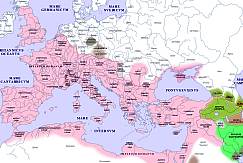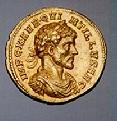Roman Emperors Dir Quintilius
An Online Encyclopedia of Roman Emperors
Quintillus (270 A.D)
Thomas M. Banchich
Just as the reputation of Gallienus suffered at the hands of pro-senatorial literary sources, that of the Illyrian Claudius II Gothicus and his brother Marcus Aurelius Claudius Quintillus (PIR2 A 1480; PLRE I, p. 759, s.v. Quintillus) benefited.[[1]] So Eutropius describes him as "a man of singular moderation and grace, and comparable or even preferable to his brother," chosen emperor by the soldiers, and, with the agreement of the Senate, named Augustus (Breviarium 9.12; cf. Orosius 7.23.1-2, where he is styled "the only Roman emperor superior to Claudius). Jerome (Chronica s.a. 271, ed. Helm, p. 222) has him acclaimed by the Senate; John Zonaras (12.26, ed. Büttner-Wobst, CSHB, pp. 605-606) records that Claudius, on his deathbed at Sirmium, in consultation with his commanders named Aurelian emperor, but that the Senate, upon learning of Claudius' death, proclaimed Quintillus (called Quintillianus by Zonaras) emperor. The Historia Augusta, hereafter HA, attributing his death to the reaction of his troops against his attempt to impose discipline, likens his fate to that of Galba and Pertinax, both regarded in the literary sources as noteworthy champions of the Senate, and attributes the inconsequentiality of his reign to its brevity (Claudius 12). A military milestone near Tagremart in Mauretania (Dessau ILS 573) records his official titles: "To Imperator Caesar Marcus Aurelius Claudius Quintilus, Unconquered, Pious, Happy, Augustus, Pontifex Maximus, [Holder of ] Tribunician Power, Father of his Country ... ."[[2]] Legends and images on these coins reflect the high priority he gave to winning the loyalty of the Danubian legions.[[3]]
The biography of Aurelian in the HA (Aurelian 37.5-6) tells a slightly different story. It puts Quintillus in command of a garrison (praesidium) in Italy at the time of Claudius' death. He seizes power but, having learned of Aurelian's ascendancy and having failed in an attempt to turn his troops against Aurelian, finds himself abandoned and commits suicide by opening his veins on the twentieth day of his reign. Earlier, the HA quotes an alleged letter from Claudius to Aurelian, appointing the latter commander in the ongoing campaign against the Goths and assuring him that Quintillus, when he links up with him, "will be with him." (Aurelian 13.3: tecum erit etiam frater Quintillus, cum occurrerit).
Accounts vary with regard to the precise circumstances of Quintillus' death and the duration of his reign. Zonaras (loc. cit.), agreeing with the Vita of Aurelian in the HA (Aurelian 37.6) says that he opened his veins and died "just as if having dreamed his reign for 17 days." John of Antioch (fr. 154 FHG IV, p. 599) reflects that same tradition, recording that Quintillus, when he learned of Aurelian's proclamation as emperor, had a physician open his veins. However, at Aurelian 16.1 the HA speaks of Quintillus as having been murdered and -- if one accepts the unlikely emendation of the 17th-century editor Claudius Salmasius from the transmitted Claudium to Quintillum -- in its biography of Claudius, notes that Dexippus did not explicitly say Quintillus was murdered but simply, and without specifying a cause, that he died (Claudius 12.6 = FGrH 100 fr.23: et Dexippus quidem Quintillum non dicit occisum, sed tantum mortuum. nec tamen addit morbo, ut dubium sentire videatur) . Jerome (loc. cit.) has Quintillus killed at Aquileia after 17 days, while the Chronographer of 354 (ed. Mommsen, MGH AuctAnt IX.1, p. 148) agrees that he was killed at Aquileia, but after a reign of 77 days.
The length of Quintillus' reign as recorded in ancient sources ranges
from a few days (Epitome de Caesaribus 34.5, ed. Pichlmayr, p. 161) --
seventeen being the most common figure -- to a few months (Zosimus
Historia nova 1.47, though Casaubon would emend the transmitted "months"
[



 ] to "days" [
] to "days" [




 ]).[[4]] The earliest mentions of Aurelian as emperor do not necessarily provide a terminus for the rule of
Quintillus, for there clearly was some overlap. Whatever the length of
his reign, it was of sufficient time to allow most of the mints of the
empire to strike issues bearing his name.[[5]]
]).[[4]] The earliest mentions of Aurelian as emperor do not necessarily provide a terminus for the rule of
Quintillus, for there clearly was some overlap. Whatever the length of
his reign, it was of sufficient time to allow most of the mints of the
empire to strike issues bearing his name.[[5]]
HA Claudius 13 gives a confused and highly suspect account of Quintillus' Illyrian family, naming, along with Claudius Gothicus, a probably fictitious brother Crispus. An equally suspect Claudia, daughter of this Crispus, is said to have married an almost certainly fabricated Eutropius, from which union allegedly came Constantius Chlorus, the father of Constantine the Great. Quintillus, also according to Claudius 13, was survived by two sons.[[6]]
Notes
[[1]]Andreas Alföldi, "The Crisis of the Empire," Chapter VI of The Cambridge Ancient History (Cambridge: Cambridge University Press, 1939), Vol. XII, p. 192. asserts that "The authorities deserve full belief when they tell us that the brother of the dead Emperor ... was chosen emperor by the Senate." Alföldi thinks that Quintillus was in command of mobile troops set to defend Italy from barbarian incursions, and that, upon Claudius' death, he presented himself before the Senate in Rome, promised a never-delivered largesse to the population of the city, and then, after his senatorial acclamation as Emperor, departed for Aquileia. While all this is reasonable, it goes well beyond the actual evidence. The same may be said for Alföldi's later characterization of Quintillus as "the Senate's tool" (p. 196).
[[2]]IMP. CAES. M. AU|RELIO CLAUDIO | QUINTILO INVIC|TO PIO FELICI AUG. | PONT. MAXIMO, TR|IB. POTEST., P.P., COH. | BREUC. | M. P. IIII.
[[3]]So Alföldi, CAH VI, p. 193.
[[4]]"Seventeen" in Eutropius, Jerome, Orosius, and Zonaras in the passages cited above, and at HA Claudius 12. Aurelius Victor's comments on Quintillus are lost due to a lacuna (34.7, Pichlmayr, p. 113). For a
full list of testimony, see Francois Paschoud, Zosime, Histoire Nouvelle
(Paris: Société d' édition "Les Belles Lettres", 1971) I, p. 162, n.
75. The discrepant lengths might be traceable to the misreading, either
in course of producing copies or of during research, of the Greek
numerical notation of a correct 77 for 17 -- i.e., OZ for IZ -- in a
writer, possibly Dexippus, who influenced a now-lost Latin source --
Enmann's Kaisergeschichte ? -- drawn upon by later authors.
"Seventy-seven," correctly transmitted by the Chronographer of 354
(loc. cit.), then, would reflect the Greek original, generalized by
Zosimus into "a few months" and rounded off at HA Aurelian 37.6 to
"twenty." The remainder of the relevant Latin sources would reproduce
the incorrect "seventeen." But what is the explanation, then, of
Zonaras' "seventeen?" Two possibilities are scribal error in the
transmission of Zonaras' text or, less likely, a conscious correction by
Zonaras or a copyist influenced by the dominant tradition of
"seventeen." However, if the mistaken "seventeen" for "seventy-seven"
was already present in the Greek source, Zonaras' "seventeen" is
understandable and Casaubon's emendation of Zosimus from "a few months"
to "a few days" would be necessary to bring that author in line with the
erroneous tradition. Indeed, the emendation involves letters commonly
confused in uncial: 












 to
to 













 . This argument
would make the Chronographer of 354 the only source to preserve the
correct length of Quintillus' reign.
. This argument
would make the Chronographer of 354 the only source to preserve the
correct length of Quintillus' reign.
[[5]]Harold Mattingly, "The Imperial Recovery," Chapter IX of CAH XII, p. 297, with references, notes that aside from Antioch, then controlled by Zenobia, all imperial mints struck for Quintillus.
[[6]]Cf. PIR2 C 1064, PLRE I, p. 206, s.v. Claudia 2; PIR2 C 1595, PLRE I, p. 232, s.v. Crispus 1; and PIR.2 E 129, PLRE I, p. 316, s.v. Eutropius 1. See, too, Ronald Syme, Historia Augusta Papers (Oxford: Oxford University Press, 1983), pp. 63-79, especially p. 69.
Copyright (C), Thomas M. Banchich This file may be copied on the condition that the entire contents, including the header and this copyright notice, remain intact.
For more detailed geographical information, please use the DIR/ORBAntique and Medieval Atlas below. Click on the appropriate part of the map below to access large area maps.

 DIR Atlas
DIR Atlas